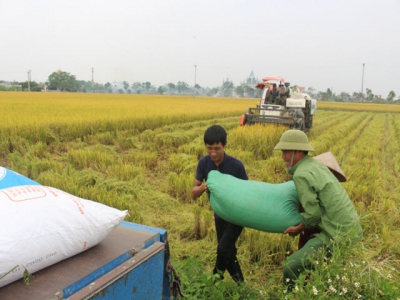Northern Vietnam enjoys bumper rice harvest

Having faced hardships, rice growers in northern Vietnam still witnessed a turnaround in 2020 with the rice output of 13 million tonnes (an increase of 122,000 tonnes year on year).
Rice production in northern Vietnam witnessed an incredible turnaround, thereby ensuring food security and exports. Photo: Mai Chien.
On November 12, the Ministry of Agriculture and Rural Development (MARD) held a conference in Nam Dinh Province, to review the rice production in 2020, and prepare for the winter-spring crop in 2020-2021.
Increased rice yield
In 2020, rice producers encountered a number of difficulties such as the risk of crop diseases in the winter-spring crop and impact of the Covid-19 pandemic; however, they reaped a bumper harvest with a rise in profit and a fall in production cost, said Deputy Minister of Agriculture and Rural Development Le Quoc Doanh.
By the end of November, 2020, the rice export in 2020 reached some 6 million tonnes with the export turnover of about US$ 3 billion, a 11% increase in value year on year. Meanwhile, the rice quality continues to be boosted.
According to the Department of Crop Production, MARD, in 2020, rice was grown on an area of 2.3 million hectares, a fall of about 36 thousand hectares year on year. This is because some growers turned to other high-value crops, and some areas were stricken by droughts or were used for other purposes.
The average rice yield of the 2020 of the northern provinces is estimated at 57.1 quintal/ha, a rise of 1.4 quintal/ha compared to 2019.
The total rice output is expected to stand at over 13 tonnes, a rise of 122 thousand tonnes year on year.
Measures to cope with prolonged cold spell
In the 2020-2021 winter-spring crop, rice is projected to be grown on an area of 1,088 million hectares, a decrease of about 9.6 thousand hectares compared to the same period last year. According to the National Centre for Hydro-Meteorological Forecasting, the period from the end of December 2020 to February 2021 is likely to undergo severe cold weather. Some cold spells are expected to last in 7-10 days and even more in the northern mountainous provinces.
The harsh weather conditions can lengthen the growth of rice in the 2020-2021 winter-spring. As low temperatures can harm the flowering process, it is necessary to allow for a proper timeline so that rice can be grown in the most conducive conditions. This is even more important in provinces in Red River Delta and northern midlands and mountainous area where the harsh weather conditions are due.
Department of Crop Production advised that sowing should be done mostly after Feb 3, 2021, and high-quality, pest-resistant, short-duration rice varieties are encouraged. Every locality needs to devise a rice production plan for 2020-2021 winter-spring and summer-autumn and winter crops in 2021.
Besides, it is also vital to employ water-saving irrigation measures, make use of water out of high tides, while following the schedule of water discharge from reservoirs to store enough water for use.
Cold tolerant rice varieties prioritized
By November 5, rice seeds have been sowed on an area of 295,000 hectares, accounting for 73% of the planned one.
Specifically, 78 thousand hectares and 212 thousand hectares of rice seeds have been planted in the North Central Coast and in Red River Delta and northern midlands and mountainous area respectively.
Major farming areas are seen in such provinces as Thai Binh, Hanoi with 25 thousand hectares, Hai Duong with 20 thousand hectares and Bac Giang with 16 thousand hectares and Vinh Phuc with 11 thousand hectares.
The Department of Crop Production also underscored that currently, it was no longer suitable to sow of crop varieties that could grow best in warm weather condition.
Instead, it is time to plant varieties that grow best in cold weather such as leafy greens and potatoes. The growing areas of higher-value crops should be expanded.
Besides, crop rotation should be effectively adopted in order to avoid the redundance of vegetables.
In addition, it is important to plan and import a reasonable number of potato seeds. The quality of potato varieties also needs to be examined carefully.
Related news
 Province makes restructuring of agriculture for development
Province makes restructuring of agriculture for development Along with absorbing investment projects, promoting industrial production and services, Binh Duong province will further boost restructuring
 Hi-tech agriculture towards quality and efficiency
Hi-tech agriculture towards quality and efficiency The province’s agriculture, especially hi-tech agricultural models needs to promote sci-tech research, application and transfer into production for better
 Agriculture improves added values towards sustainable development
Agriculture improves added values towards sustainable development The province’s agriculture and rural development sector has reached positive paces, significantly contributing to the local socio-economic development.